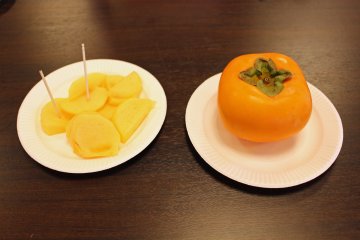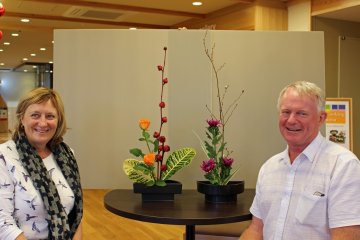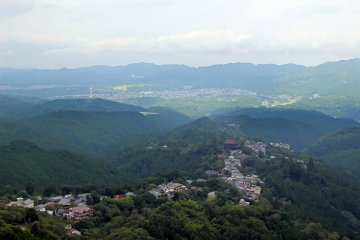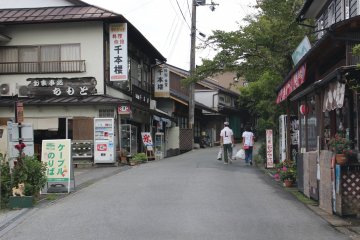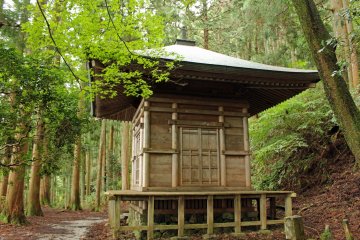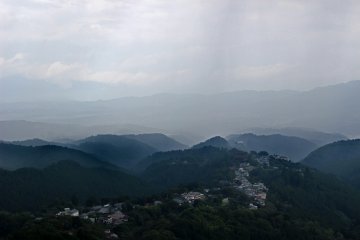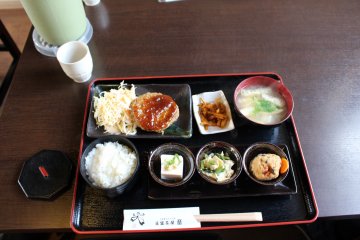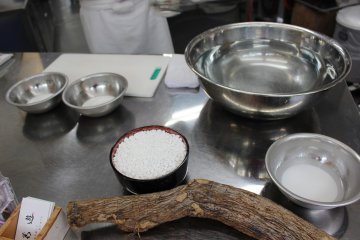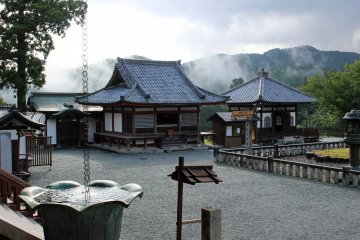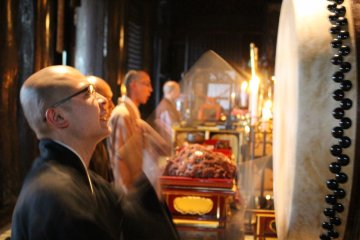The birthplace of the Shugendo sect of Buddhism (the practice of achieving enlightenment through tapping into the power of nature one is surrounded by), home to ancient temples and shrines amid a forest of 30,000 sakura trees, and an isolated mountain retreat where an ousted Emperor and aristocrats who had lost favor in Kyoto established a rival court. This is the town of Yoshino and it’s now easier and cheaper to visit than ever!
From July 24th through October 31st of 2015 the NARA Visitor Center will operate the Nara Excursion Bus service to both Asuka Village and the Town of Yoshino. The bus is free to the first 27 people to sign up to ride at the Visitor Center near the Sarusawa-ike Pond. The inaugural bus took me to see the sites of Asuka and when this opportunity arose, I took the bus to Yoshino.
The bus was scheduled to arrive in Yoshino at 11:05 in the morning but was about 20 minutes early due to light traffic. I was fortunate enough to have a local guide to drive me around but the other guests were obliged to either wait about 40 minutes for the next local “Cable Bus” or to walk the 1.2km to Kinpusenji Temple. The Town of old Yoshinoyama starts between the Shimosenbon bus stop and Kinpusenji Temple and is full of old wooden and wood fronted buildings from the Meiji, Taisho and early Showa periods. It offers a glimpse into the Japan of days past. Many stores and cafes serve coffee and local foods making it an excellent stop off for a snack or a bento. There is also a “Cable Bus” bus stop in front of the Yoshinoyama Ropeway (aerial tram) station and an 11:40am bus to take visitors to Okusenbon at the top of Yoshino Mountain (¥500).
A narrow and winding road through beautiful old buildings and forests of sakura and cedar trees led to the first stop on my visit, Kinpu Shrine right at the top of Yoshino Mountain. The shrine’s exact dates of founding are unclear but it is an important stop for Shugendo Buddhist pilgrims on their trek into the mountains on their quest for enlightenment. Kinpusenji’s most interesting site is the “Kakure-to” hideout pagoda where the samurai Minamoto no Yoshitsune once hid from soldiers sent by his older brother Yoritomo, an increasingly violent and jealous warlord, to arrest and kill him. Visitors to the Kakure-to are also allowed to go inside the pagoda and partake in a Shugendo chant led by one of the shrine’s monks. The chanting is conducted in complete darkness inside the pagoda while walking around the central altar 3 times in a clockwise direction and keeping one’s hand on the wall. When all participants have completed 3 circuits and chants the monk rings a bell. The ceremony is meant to cleanse the mind and body of evil spirits before journeying into the mountains (or back into the real world). This Shugendo ceremony is only available in Japanese and I wish the monk had practiced the correct pronunciation of the chant with us before the ceremony, but it was still a cool experience.
1.6 kilometers down Yoshino Mountain is Yoshino Mikumari Shrine, the southern of the four “Yamato Mikumari Shrines” (the 4 Mikumari Shrines of old Nara the other 3 being Uda, Katsuragi and Tsuge Mikumari Shrines). The name “Mikumari” means watershed and the shrine is dedicated to Ame no Mikumari no Kami the water goddess in charge of the distribution of rain and water across old Nara. Her altar and those of 6 other gods are housed inside the beautiful and unusual main hall. The building is much longer than it is wide to allow all of the shrine’s deities to be housed under one roof. Since the 9th century Mikumari Shrine has also attracted those wishing to pray for children and a safe birth. The present day shrine was reconstructed in the 17th century at the order of Toyotomi Hideyori, the son of Toyotomi Hideyoshi (the 16th century warlord who unified Japan), as a sign of gratitude to his father who supposedly prayed for the birth of his son at this shrine.
A short walk down the road from Mikumari Shrine is what maybe the best view on Yoshinoyama, the Hanayagura Observation Point. The viewing point is directly above a steeper slope on the mountain allowing visitors to look down through the forest of sakura trees to the looping road below. Above that one can see all the way down to the great form of Kinpusenji Temple’s roof rising high above all the other buildings in the town of Yoshino on the lower slopes of the mountain, and then beyond that to the town of Oyodo and the valleys and mountains beyond.
Afternoon was already upon us and our stomachs were reminding us that they were empty. My guide took me to Tofu Chaya Hayashi, a restaurant specializing in, as its name suggests, tofu dishes. I was concerned that this meant no meat at all but was happy to learn that this is not the case. Tofu Chaya Hayashi does use meat in its dishes but the main aspect is the tofu. The dish with the most meat and volume is the Tofu Burger set meal, featuring a mixed meat and tofu burger pate, 3 dishes of tofu prepared 3 different ways, a plate of Nara-dzuke (Nara vegetable pickles) and rice and a bowl of miso soup with fried tofu. The burger and the fresh cold tofu in soy sauce with shredded ginger. Taking alternating bites of a hot burger with sauce and some spices and the cold simply seasoned tofu was refreshing.
There was still room for dessert after lunch and the chance to try a locally made sweet and to watch the chemistry demonstration that is its preparation could not be missed. Kudzu mochi, kudzu kiri and kudzu manju are traditional Yoshino sweets made from the starch of the kudzu plant and water, and the sweets chef at the Nakai Shunpudo Sweets Shop has an open kitchen to show the process. The main difference between the three sweets is the amount of water used (more water is needed to make the kudzu mochi and kudzu manju with sweet red bean paste).
“Normally, water and starch don’t mix, just like oil and water don’t mix,” explained the chef (in Japanese) while displaying two metal bowls of water with a pile of white kudzu starch at the bottom. “So how do you get the starch to mix with the water? If you did a similar experiment in chemistry class then you know that it has to be heated.” The chef stirred up the kudzu mocha with a whisk, poured it into a pan and put it on the stove. “If you heat up the starch it absorbs the water and becomes clear.” And it did. The kudzu kiri, whisked, poured into a square pan and steamed in a tray of hot water, was even more impressive. The chef floated the pan on the surface of the water and rocked the liquid kudzu kiri back and forth until the entire solution had, quite abruptly, solidified. “Now to make the kudzu kiri go clear! Ready?” He sank the pan in the water and almost instantly, the kudzu kiri went transparent. “Now it’s ready to be eaten.” The chef then cut and prepared both the kudzu mochi and the kudzu kiri for serving, informing us that we only had 10 minutes to eat it before the starch and the water started to separate and ruin the flavor. Both the kudzu mocha and kudzu kiri were served with a sweet Japanese brown sugar and Japanese molasses accompanied by a cold cup of tea and were an excellent dessert.
With just over an hour till the bus left, my guide took me to Yoshino’s largest temple, Kinpusenji, the Temple of Golden Peaks. Kinpusenji was founded in the mid-7th century by En no Gyoja, the founder of Shugendo and remains the headquarters of Japanese Shugendo to this day. The largest and main structure on the temple grounds, the Zao-do Hall, was built in 1592. The massive 34 meter tall structure is held up by 68 giant pillars, as large as 1.2m in diameter, made from locally harvested cedar trees and is the second largest wooden building in Japan after Todaiji’s Great Buddha Hall. During the spring cherry blossom season and once again during the fall, the three statues of Kinpusenji’s and Shugendo’s fierce looking main deity, the blue skinned and wild boar tusked Zao Gongen are put on display for viewing and worship. Each statue is over 1300 years old and up to 7 meters in height and embody the worlds of the past, present and future. I stayed the night in Yoshino and participated in a morning prayer ceremony the next day (an interesting and beautiful experience with the ringing of bells, pounding of ceremonial taiko drums and chanting of several monks), but did not coincide with a chance to see the statues of Zao Gongen. Pictures I’ve found in a couple of brochures are very impressive. The smaller statues of Zao Gongen and his support deities in the Zao-do Hall are fierce enough looking that visitors might imagine them charging down the dark halls of the temple to strike down evil spirits with the dual tridents they hold in their right hands.
The Yoshino Bus Trip, and any trip to Yoshino, will involve a fair bit of walking to take in all the sites Yoshino has to offer, but the sakura season flowers and autumn leaves in their respective seasons and the beautiful environment and deep history of the area make it well worth it. Happy Travels!





